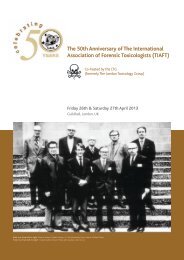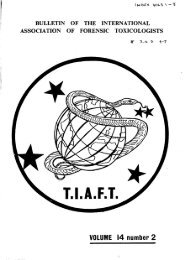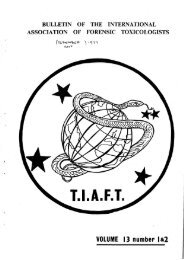Volume XLI Number 1.pdf - The International Association of Forensic ...
Volume XLI Number 1.pdf - The International Association of Forensic ...
Volume XLI Number 1.pdf - The International Association of Forensic ...
Create successful ePaper yourself
Turn your PDF publications into a flip-book with our unique Google optimized e-Paper software.
TIAFT BULLETIN VOLUME 41, 2011. No 1<br />
is too low, the analyte can influence the signal <strong>of</strong> the IS<br />
(26,46). Other less <strong>of</strong>ten used calibration techniques are<br />
echo peak technique, standard addition, extrapolative<br />
dilution and (segmented) post-column standard addition.<br />
In the echo peak technique an unknown sample and a<br />
standard solution are injected in one run, causing the peak<br />
<strong>of</strong> the standard to form an ‘echo peak’. Provided that<br />
retention times <strong>of</strong> these two peaks are close enough to<br />
be affected by interfering substances in the same manner,<br />
matrix effects are compensated (44,49). Since the smallest<br />
difference in retention time can cause a difference in<br />
matrix effects, this approach may not be optimal for<br />
analyzing forensic samples which can contain several<br />
interferences. Standard addition is a method to quantify<br />
analytes by analyzing the unknown sample before and<br />
after addition <strong>of</strong> standard solution (50). This procedure is<br />
time consuming because spiked samples must be run for<br />
each unknown. In the extrapolative dilution approach, a<br />
sample is repeatedly diluted until the limit <strong>of</strong> quantitation<br />
is reached (51). <strong>The</strong> concentration <strong>of</strong> the analyte in each<br />
dilution is calculated using a calibration curve based<br />
on standard soluitions (51). By plotting the calculated<br />
concentration versus the dilution factor, matrix effects<br />
can be detected and the correct concentration can be<br />
determined (51). This is a labour intensive method since<br />
several dilutions for each sample have to be analysed.<br />
In forensic toxicology, these time consuming approaches<br />
(standard addition and extrapolative dilution approach)<br />
might be interesting to study rare cases, analyzing<br />
compounds that are not comprised in generally validated<br />
methods. In (segmented) post-column standard addition,<br />
an internal standard is (periodically) infused into the LC<br />
effluent to visualize and compensate for matrix effects<br />
using the principle shown in fig. 4B (52,53). Co-elution <strong>of</strong><br />
internal standard and analyte <strong>of</strong> interest is not necessary,<br />
so isotopically labelled standards are not required and<br />
one compound can be used for several analytes, making<br />
this approach interesting for multi-analyte procedures<br />
(52). However, one should be aware that only the use <strong>of</strong><br />
an IS can adequately compensate for variable signal loss<br />
attributed to both sample preparation and matrix effects.<br />
Echo peak technique, standard addition, extrapolative<br />
dilution and (segmented) post-column standard addition<br />
are best applied to methods where the loss during sample<br />
preparation is minimal since they only compensate for<br />
altered signals caused by matrix effects. <strong>The</strong> complexity<br />
<strong>of</strong> forensic samples can cause variability in both sample<br />
preparation and matrix effects, making the use <strong>of</strong> an IS to<br />
solve matrix effects more suited.<br />
5. Conclusion<br />
Matrix effects are the major problem <strong>of</strong> LC-MS/MS. <strong>The</strong>y are<br />
dependent on the analyte, the matrix and the ionization<br />
interface used. <strong>Forensic</strong> toxicology is <strong>of</strong>ten influenced by<br />
these matrix effects, since forensic samples can have a<br />
complex compostion, containing multiple components<br />
which may possibly disturb analysis. Evaluation <strong>of</strong><br />
Page 14<br />
matrix effects should be an integral part <strong>of</strong> method<br />
development in forensic toxicology. If matrix effects occur,<br />
adaptations in the amount <strong>of</strong> sample, sample preparation,<br />
chromatography, mass spectrometry or calibration can<br />
eliminate, reduce or at least compensate for matrix effects.<br />
References<br />
1. A. Polettini. Applications <strong>of</strong> LC-MS in toxicology, 1st ed.<br />
Pharmaceutical Press, London, UK, 2006.<br />
2. O.H. Drummer and M. Odell. <strong>The</strong> <strong>Forensic</strong> Pathology <strong>of</strong><br />
Drugs <strong>of</strong> Abuse, Arnold, London, UK, 2001.<br />
3. O.H. Drummer. Postmortem toxicology <strong>of</strong> drugs <strong>of</strong> abuse.<br />
<strong>Forensic</strong> Sci Int. 142: 101-113 (2004).<br />
4. B.K. Matuszewski, M.L. Constanzer and C.M. Chavez-<br />
Eng. Strategies for the assessment <strong>of</strong> matrix effect in<br />
quantitative bioanalytical methods based on HPLC-MS/<br />
MS. Anal Chem. 75: 3019-3030 (2003).<br />
5. M.C. Yarema and C.E. Becker. Key concepts in<br />
postmortem drug redistribution. Clin Toxicol (Phila). 43:<br />
235-241 (2005).<br />
6. S.M. Wille and W.E. Lambert. Recent developments in<br />
extraction procedures relevant to analytical toxicology.<br />
Anal Bioanal Chem. 388: 1381-1391 (2007).<br />
7. S.D. Clarke, H.M. Hill, T.A.G. Noctor and D. Thomas.<br />
Matrix-related modification <strong>of</strong> ionization in bioanalytical<br />
liquid chromatography-atmospheric pressure ionization<br />
tandem mass spectrometry. Pharmaceutical Sciences.<br />
2: 203-207 (1996).<br />
8. C. Polson, P. Sarkar, B. Incledon, V. Raguvaran and R.<br />
Grant. Optimization <strong>of</strong> protein precipitation based upon<br />
effectiveness <strong>of</strong> protein removal and ionization effect in<br />
liquid chromatography-tandem mass spectrometry. J<br />
Chromatogr B Analyt Technol Biomed Life Sci. 785: 263-<br />
275 (2003).<br />
9. X.H. Chen, J.P. Franke, J. Wijsbeek and R.A. de Zeeuw.<br />
Isolation <strong>of</strong> acidic, neutral, and basic drugs from whole<br />
blood using a single mixed-mode solid-phase extraction<br />
column. J Anal Toxicol. 16: 351-355 (1992).<br />
10. M.C. McMaster. LC/MS: a practical user’s guide, Wiley-<br />
Interscience, New Jersey, US, 2005.<br />
11. M.I. Churchwell, N.C. Twaddle, L.R. Meeker and D.R.<br />
Doerge. Improving LC-MS sensitivity through increases in<br />
chromatographic performance: comparisons <strong>of</strong> UPLC-<br />
ES/MS/MS to HPLC-ES/MS/MS. J Chromatogr B Analyt<br />
Technol Biomed Life Sci. 825: 134-143 (2005).<br />
12. D. Guillarme, J. Ruta, S. Rudaz and J.L. Veuthey. New<br />
trends in fast and high-resolution liquid chromatography:<br />
a critical comparison <strong>of</strong> existing approaches. Anal<br />
Bioanal Chem. 397: 1069-1082 (2010).<br />
13. J.M. Cunliffe and T.D. Maloney. Fused-core particle<br />
technology as an alternative to sub-2-microm particles<br />
to achieve high separation efficiency with low<br />
backpressure. J Sep Sci. 30: 3104-3109 (2007).<br />
14. R.W. Brice, X. Zhang and L.A. Colon. Fused-core, sub-<br />
2 mum packings, and monolithic HPLC columns: a<br />
comparative evaluation. J Sep Sci. (2009).<br />
15. A. Bruins. Mechanistic aspects <strong>of</strong> electrospray ionisation.<br />
J Chromatogr A. 794: 345-357 (1998).<br />
16. R.B. Cole. Some tenets pertaining to electrospray<br />
ionization mass spectrometry. J Mass Spectrom. 35: 763-<br />
772 (2000).<br />
17. L. Peng and T. Farkas. Analysis <strong>of</strong> basic compounds by<br />
reversed-phase liquid chromatography-electrospray<br />
mass spectrometry in high-pH mobile phases. J







